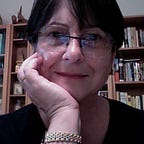Why Reading Aloud Matters
When I was in 5th grade, my beloved teacher read aloud to us every week — an experience I cherished. I couldn’t wait for those days when she would open Lloyd Alexander’s The Book of Three and spin me into a place that was at once spellbinding, suspended in time, and intensely activating. You’d think that listening to someone read would be a passive activity, but not for me, at least. Quite the opposite. My brain was going a mile a minute and fully engaged.
Remembering that cherished activity, I recently asked one of the teachers at my school if I could read aloud to her 6th graders, and she readily agreed. So, once a week, for the past 8 months, I read Neil Gaiman’s The Graveyard Book to them. From the moment I spoke the first line — “There was a hand in the darkness, and it held a knife” — those kids were spellbound. And they stayed spellbound every single week, often clamoring in dismay when I left them hanging, begging to know what was going to happen next.
And you know what? These were all boys. Fidgety, active, boys with the attention span of a gnat.
Yet while I read to them, in the stillness of the room, many kids put their heads down on their desks, so they could better imagine the details for themselves. Nobody fiddled or stared in boredom out of the window.
I consider The Graveyard Book to be the perfect work of fiction for 21st century learning because it wraps deeper themes of community, diversity, identity, and coming of age under the cover of action, mystery, drama, excitement, derring-do. After each reading, there was so much to talk about! What was Silas, really? and the clues Gaiman deftly wove into his writing that eventually led us to the realization of his identity; why Liza was buried outside the graveyard; how the word “sussurus,” with its onomatopoeia, sounds like the Sleer. And how characters we normally stereotype as “bad guys” — vampires, werewolves, and witches — turned out to be not so black-and-white.
By reading 10 pages or so aloud every week, my students, like tea, steeped in the story as it slowly unfolded. They deeply empathized with Bod through all his adventures and travails, and they all applauded the end, even though they felt wistful that the book was over. They made friends with Bod in a way that, perhaps, they mightn’t have done if they had read the book alone.
Reading aloud gave me the stage to create different voices for characters, to gesture and articulate with inflection, thereby acting the story. So it was as much a performance as a reading, with the students as the audience. Importantly, the activity cleaved a quiet space in the middle of students’ crammed days that allowed for quiet consumption.
These days, consumption is a dirty word, but in this context, I don’t think it is. In fact, quite the opposite: These kids’ brains were actively assimilating, thinking, imagining, and creating pictures in their minds. Indeed, at the end of the book, one boy asked if there were an illustration of Silas, one of the more mysterious characters. Before I showed him, I allowed as how I wasn’t fond of illustrations in books, because they always collided with my own interpretation of what the character looked like. But then I showed the illustration, and one boy immediately howled, “That doesn’t look like my Silas at all! My Silas is a big fat guy!” We all cracked up — after all, when’s the last time you saw a fat vampire? — but that demonstrates how vastly different, yet all valid, our responses to literature can be.
My deepest hope is that those students will always remember how they felt as I read to them. Perhaps if one of them grows up to be a teacher, he will pay it forward and read to his kids.
If you like what you’ve read, be sure to hit recommend below, to pass this story along to your followers! As always, consider following The Synapse for more authentic voices in Education!
